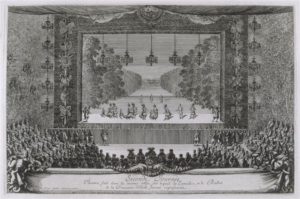By Sasha Kalter-Wasserman
Title: Seconde journée: Représentation du ballet et de la princesse d’Élide
Artist: Israël Silvestre (b. 1621, Nancy, France; d. 1691, Paris)
Date: later reprint of 1664 plate
Medium: Etching and engraving
Classification: Prints
Dimensions: Approximately 11 x 16.7 inches
Metropolitan Museum of Art
Credit Line: Harris Brisbane Dick Fund, 1930
MMA Accession Number: 30.22(32.45)
Image Source: Wikimedia Commons
Depicting a scene from La Princesse d’Élide, a five-act comédie-ballet staged in the gardens of Versailles in 1664, Israël Silvestre’s engraving is a visual record of an ephemeral but pivotal festival that marked the confluence of performing arts, court culture, and political power during the reign of Louis XIV (r. 1643–1715). Along with fellow engravers and printmakers Jean Berain (b. 1640, Saint-Mihiel, France; d. 1711, Paris), François Chauveau (b. 1613, Paris; d. 1676, Paris), and Jean Lepautre (b. 1618, Paris; d. 1682, Paris), Silvestre was commissioned to document the accomplishments of the king’s reign. Prints of the splendors of Versailles, from the château’s architecture to the lavish outdoor spectacles such as the one shown here, were published in sumptuously illustrated festival books to commemorate these events. Sent abroad as diplomatic gifts, they also served as propaganda for the power of Louis XIV and the superiority of French culture. While these courtly spectacles were intended to provide pleasure, the ultimate goal in memorializing them through the medium of prints was to underscore that all pleasure derived from the king and from his absolute power to command such performances.
As the etching’s title suggests, La Princesse d’Élide took place on the second evening of an elaborate seven-day festival entitled Les Plaisirs de l’île enchantée. Consisting of equestrian parades, chivalric contests, ballet and theatre performances, and fireworks displays, Les Plaisirs de l’île enchantée was the first of three royal fêtes that Louis XIV held at Versailles between 1664 and 1674. Within a historical context, Silvestre’s engraving of La Princesse d’Élide has multiple levels of significance: it marks the first theatrical commission by the young king, the first held at Versailles, the first of the genre of comédie-ballet (which replaced the ballet de cour that dominated the era of Louis XIII), and the first collaboration between composer Jean-Baptiste Lully (b. 1632, Florence; d. 1687, Paris) and dramatist Jean-Baptiste Molière (b. 1622, Paris; d. 1763, Paris). In La Princesse d’Élide, Lully and Molière created a polymorphic art form comprising ballet, scenography, costume design, music, poetry, and prose. Beyond the literal representation of a theatrical work, therefore, Silvestre documents a transformative moment in the reign of Louis XIV, the history of Versailles, and the evolution of French theatre.
From the precise details of Silvestre’s rendering, the scale and splendor of the production imbue the work with a realism that belies the temporary nature of the theatre itself. What appears to be a monumental structure was in fact an outdoor stage specially constructed in the Allée Royale of the gardens. Conflating the bucolic natural setting with the artifice of a stage set, Silvestre depicts the ambiance created by the technical achievements of the king’s architects and designers. Within this expansive scene, the performance space is a platform elevated above the level of the spectators, who are seated in neat, tiered rows on both sides of a proscenium stage framed by enormous tapestries. Vertically suspended from scaffolding, these hangings create a literal divide between the enclosed environment of the outdoor theatre and the vast natural world of the gardens. Here, Silvestre invites the viewer to willingly suspend disbelief about whether the trees and animals seen in the tapestries are real or not. Further conflating the ambiguity between natural setting and artifice, Silvestre meticulously renders the chandeliers, curtains, roof created from billowing draperies, and even the partially enclosed space for Lully’s musicians. The artist also captures the use of stagecraft to provide a perspective in which costumed performers in the foreground are on the raised platform of the stage itself, whereas those in the background appear to be in the garden, which offers a real-life panorama of trees, sculptured hedges, and a pond.
A scene within a scene, Silvestre’s engraving can also be read as two parallel royal romances: the allegorical narrative of Molière’s comédie galante unfolding onstage, where the mythical princess Élide is being wooed by her prince, and the symbolic narrative in the audience, where Louis XIV is seated alongside his queen (Marie-Thérèse) but has planned the spectacle for his mistress, Louise de la Vallière, presumably just rows away. Through scale and perspective, Silvestre establishes the implicit social hierarchy, with the king seated front row center in the most elevated viewing position. Flanked by the highest-ranking members of the royal family, Louis XIV is the largest figure in the composition, his body aligned with the vertical axis that runs though the middle of the engraving. This placement underscores his status as the corporeal embodiment of his kingdom and the metteur en scène not only of this fête but also of Versailles, which he will soon transform into the political epicenter of France.
